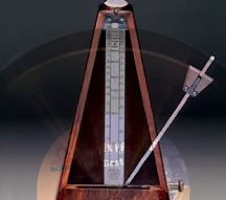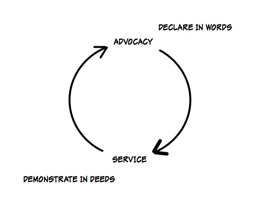 I’ve been playing with the idea of seeing movement building like a metronome. As you know, a metronome produces a regulated audible and/or visual pulse, usually used to establish a steady beat, or tempo, measured in beats-per-minute (BPM) for the performance of musical compositions. It is an invaluable practice tool for musicians that goes back hundreds of years.
I’ve been playing with the idea of seeing movement building like a metronome. As you know, a metronome produces a regulated audible and/or visual pulse, usually used to establish a steady beat, or tempo, measured in beats-per-minute (BPM) for the performance of musical compositions. It is an invaluable practice tool for musicians that goes back hundreds of years.
In wind-up metronomes like the one pictured here an adjustable weight on the end of a rod controls the tempo: slide the weight up the rod to decrease tempo, or down the rod to increase tempo. The pendulum rod swings back and forth in tempo; mechanics inside the metronome usually produce a clicking sound on each swing of the rod.
Obviously, to establish a particular tempo, the pendulum must swing back and forth. If it stops on either side, there is no beat, no rhythm.
The metronome of spiritual movements is the pendulum swing between passionate proclamation and compassionate demonstration of the gospel. The movement leader must ensure a rhythm is developed in which the movement moves constantly to the whole beat of declaring in words and demonstrating in deeds the kingdom message. A movement can’t afford to stop at either side; it must constantly cycle back and forth.
Crutchfield and Grant in their excellent book “Forces for Good: The Six Practices of High-Impact Nonprofits” argue that high-impact nonprofits all possess a Virtuous Cycle. The Virtuous Cycle refers to the cycle of “policy advocacy and direct service” that works together to create impact greater than the sum of the parts. In other words, nonprofits like Habitat for Humanity or Teach for America can’t settle for advocacy only. To build movements, they must both advocate for their cause and provide a direct service. In words the authors weren’t hesitant to use, the nonprofits who made the most impact were “evangelists” and “servants.”
 I’m increasingly convinced that all movements must possess this Virtuous Cycle in which they both “evangelize” and “serve”. As Ron Sider says in his recently republished work, “Good News and Good Works: A Theology for the Whole Gospel”, Christians must beat out a rhythm of evangelism and social action. He writes:
I’m increasingly convinced that all movements must possess this Virtuous Cycle in which they both “evangelize” and “serve”. As Ron Sider says in his recently republished work, “Good News and Good Works: A Theology for the Whole Gospel”, Christians must beat out a rhythm of evangelism and social action. He writes:
I long for a day when every village, town, and city has congregations (every campus has movements–mine) so in love with Jesus that they lead scores of people to him and so sensitive to the cry of the poor and oppressed that they work vigorously for justice, peace, and freedom.